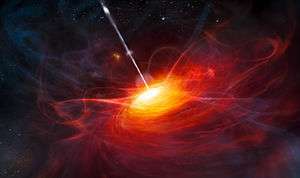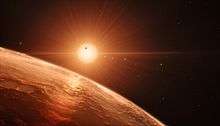ULAS J1342+0928
| ULAS J1342+0928[1][2] | |
|---|---|
 Artist concept of a similar related quasar | |
| Observation data (Epoch J2000.0) | |
| Constellation | Boötes[3] |
| Right ascension | 13h 42m 08.10s |
| Declination | +09° 28′ 38.61″ |
| Redshift | 7.54[1] |
| Distance |
29.36 Gly (9.00 Gpc) (comoving distance)[4] 13.1 Gly (4.0 Gpc) (light travel distance[5] |
| Other designations | |
| ULAS J134208.10+092838.61,[1] Quasar20171206[6] | |
| See also: Quasar, List of quasars | |
ULAS J1342+0928 is the most distant known quasar detected and contains the most distant and oldest known supermassive black hole,[1][5][6][7] at a reported redshift of z = 7.54, surpassing the redshift of 7 for the previously known most distant quasar ULAS J1120+0641.[1] The ULAS J1342+0928 quasar is located in the Boötes constellation.[3] The related supermassive black hole is reported to be "800 million times the mass of the sun".[5]
Discovery
On December 6, 2017,[1] astronomers published that they had found the quasar using data from the Wide-field Infrared Survey Explorer (WISE)[6] combined with ground-based surveys from one of the Magellan Telescopes at Las Campanas Observatory in Chile, as well as the Large Binocular Telescope in Arizona and the Gemini North telescope in Hawaii. The related black hole of the quasar existed when the universe was about 690 million years old (about 5 percent of its currently known age of 13.80 billion years old).[1]
The quasar comes from a time known as "the epoch of reionization," when the universe emerged from its Dark Ages.[5] Extensive amounts of dust and gas have been detected to be released from the quasar into the interstellar medium of its host galaxy.[2]
Description
ULAS J1342+0928 has a measured redshift of 7.54, which corresponds to a comoving distance of 29.36 billion light-years from Earth.[1][4] As of December 2017, it is the most distant quasar yet observed. The quasar emitted the light observed on Earth today less than 690 million years after the Big Bang, about 13.1 billion years ago.[5][8]
The quasar's luminosity is estimated at 4×1013 solar luminosities.[1] This energy output is generated by a supermassive black hole estimated at 8×108 solar masses.[1] According to lead astronomer Bañados,[9] "This particular quasar is so bright that it will become a gold mine for follow-up studies and will be a crucial laboratory to study the early universe."[5]
Significance
The light from ULAS J1342+0928 was emitted before the end of the theoretically-predicted transition of the intergalactic medium from an electrically neutral to an ionized state (the epoch of reionization). Quasars may have been an important energy source in this process, which marked the end of the cosmic dark ages, so observing a quasar from before the transition is of major interest to theoreticians.[10][11] Because of their high ultraviolet luminosity, quasars also are some of the best sources for studying the reionization process. The discovery is also described as challenging theories of black hole formation, by having a supermassive black hole much larger than expected at such an early stage in the Universe's history,[6] though this is not the first distant quasar to offer such a challenge.[12][13]
A small minority of sources argue that distant supermassive black holes whose large size is hard to explain so soon after the Big Bang, such as ULAS J1342+0928,[6] may be evidence that our universe is the result of a Big Bounce, instead of a Big Bang, with these supermassive black holes being formed before the Big Bounce.[14][15]
See also
- List of most distant astronomical objects
- List of quasars
- Nature timeline
References
- 1 2 3 4 5 6 7 8 9 10 Bañados, Eduardo; et al. (6 December 2017). "An 800-million-solar-mass black hole in a significantly neutral Universe at a redshift of 7.5". Nature. arXiv:1712.01860. Bibcode:2018Natur.553..473B. doi:10.1038/nature25180. Retrieved 6 December 2017.
- 1 2 Venemans, Bram P.; et al. (6 December 2017). "Copious Amounts of Dust and Gas in a z = 7.5 Quasar Host Galaxy". The Astrophysical Journal Letters. 851 (1). Retrieved 6 December 2017.
- 1 2 Staff. "Finding the constellation which contains given sky coordinates". djm.com. Retrieved 6 December 2017.
- 1 2 Wright, Ned (24 April 2016). "Ned Wright's Javascript Cosmology Calculator". UCLA. Retrieved 7 December 2017.
- 1 2 3 4 5 6 Choi, Charles Q. (6 December 2017). "Oldest Monster Black Hole Ever Found Is 800 Million Times More Massive Than the Sun". Space.com. Retrieved 6 December 2017.
- 1 2 3 4 5 Landau, Elizabeth; Bañados, Eduardo (6 December 2017). "Found: Most Distant Black Hole". NASA. Retrieved 6 December 2017.
"This black hole grew far larger than we expected in only 690 million years after the Big Bang, which challenges our theories about how black holes form," said study co-author Daniel Stern of NASA's Jet Propulsion Laboratory in Pasadena, California.
- ↑ Decarli, Roberto; et al. (September 2017). "Rest-frame optical photometry of a z-7.54 quasar and its environment". CalTech. Retrieved 6 December 2017.
- ↑ Grush, Loren (6 December 2017). "The most distant supermassive black hole ever found holds secrets to the early Universe - We're seeing how it looked when the Universe was a toddler". TheVerge. Retrieved 6 December 2017.
- ↑ Bañados, Eduardo (2017). "Eduardo Bañados - Bio/CV". Carnegie Institution for Science. Retrieved 7 December 2017.
- ↑ Matson, John (29 June 2011). "Brilliant, but Distant: Most Far-Flung Known Quasar Offers Glimpse into Early Universe". Scientific American. Retrieved 7 December 2017.
- ↑ Willott, C. (2011). "Cosmology: A monster in the early Universe". Nature. 474 (7353): 583–584. arXiv:1106.6090. Bibcode:2011Natur.474..583W. doi:10.1038/474583a. PMID 21720357. preprint of this paper
- ↑ Davide Castelvecchi (25 February 2015). "Young black hole had monstrous growth spurt". Nature. Retrieved 9 December 2017.
A black hole that grew to gargantuan size in the Universe's first billion years is by far the largest yet spotted from such an early date, researchers have announced. The object, discovered by astronomers in 2013, is 12 billion times as massive as the Sun, and six times greater than its largest-known contemporaries. Its existence poses a challenge for theories of the evolution of black holes, stars and galaxies, astronomers say. Light from the black hole took 12.9 billion years to reach Earth, so astronomers see the object as it was 900 million years after the Big Bang. That “is actually a very short time” for a black hole to have grown so large, says astronomer Xue-Bing Wu of Peking University in Beijing.
- ↑ "Discovery in the early universe poses black hole growth puzzle". Phys.org. 11 May 2015. Retrieved 9 December 2017.
Now, researchers from the Max Planck Institute for Astronomy (MPIA) have discovered three quasars that challenge conventional wisdom on black hole growth. These quasars are extremely massive, but should not have had sufficient time to collect all that mass. The astronomers observed quasars whose light took nearly 13 billion years to reach Earth. In consequence, the observations show these quasars not as they are today, but as they were almost 13 billion years ago, less than a billion years after the big bang. The quasars in question have about a billion times the mass of the sun. All current theories of black hole growth postulate that, in order to grow that massive, the black holes would have needed to collect infalling matter, and shine brightly as quasars, for at least a hundred million years. But these three quasars proved to be have been active for a much shorter time, less than 100,000 years. "This is a surprising result," explains Christina Eilers, a doctoral student at MPIA and lead author of the present study. "We don't understand how these young quasars could have grown the supermassive black holes that power them in such a short time."
- ↑ Jamie Seidel (7 December 2017). "Black hole at the dawn of time challenges our understanding of how the universe was formed". News Corp Australia. Retrieved 9 December 2017.
It had reached its size just 690 million years after the point beyond which there is nothing. The most dominant scientific theory of recent years describes that point as the Big Bang — a spontaneous eruption of reality as we know it out of a quantum singularity. But another idea has recently been gaining weight: that the universe goes through periodic expansions and contractions — resulting in a “Big Bounce”. And the existence of early black holes has been predicted to be a key telltale as to whether or not the idea may be valid. This one is very big. To get to its size — 800 million times more mass than our Sun — it must have swallowed a lot of stuff. ... As far as we understand it, the universe simply wasn’t old enough at that time to generate such a monster.
- ↑ Youmagazine staff (8 December 2017). "A Black Hole that is more ancient than the Universe" (in Greek). You Magazine (Greece). Retrieved 9 December 2017.
This new theory that accepts that the Universe is going through periodic expansions and contractions is called "Big Bounce"
External links
| Records | ||
|---|---|---|
| Preceded by ULAS J1120+0641 |
Most distant known quasar 2017 – |
Succeeded by |


